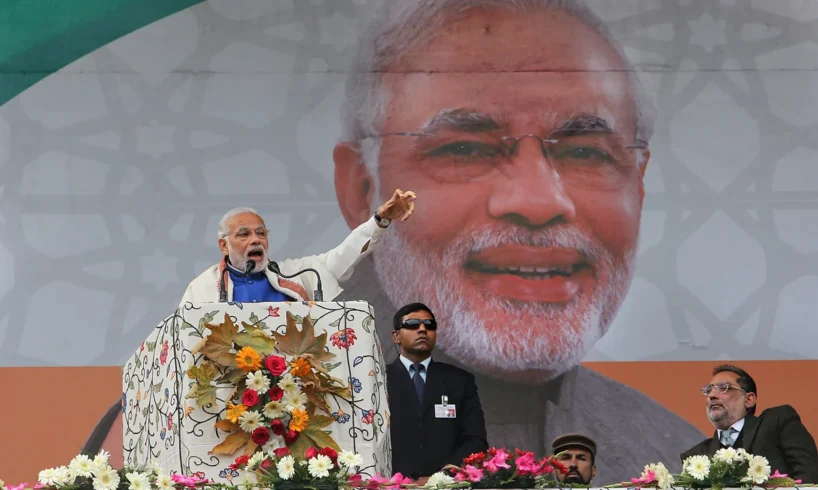
(Analysis) Prime Minister Narendra Modi has cultivated a formidable global image as a visionary leader of the “world’s largest democracy.”
Internationally, he is often received with great fanfare – from hosting the G20 summit in 2023 to being courted by Western powers eager for India’s partnership.
Modi’s government projects India as a rising economic powerhouse and a champion of the Global South. This international stature, however, contrasts sharply with the domestic reality.
At home, independent observers and rights organizations point to a troubling erosion of democratic norms and freedoms, creating a gap between Modi’s global branding and India’s internal situation.
On the world stage, Modi has largely been embraced by other leaders – often due to geostrategic and economic interests.
For instance, despite concerns about India’s democratic backsliding, the United States honored Modi with a state visit in 2023, highlighting India’s importance as a counterweight to China.
Many foreign governments downplay India’s internal issues for the sake of strategic ties. Yet global civil society and media have not overlooked India’s democratic decline.
Influential indices have downgraded India’s democratic credentials in recent years: Freedom House infamously demoted India from “Free” to “Partly Free” in 2021, and the V-Dem Institute now classifies India as an “electoral autocracy”.
These assessments underscore that while Modi advertises India as a thriving democracy abroad, domestic developments tell a more complicated story of diminishing freedoms and institutional checks.
Critics argue that Modi’s government has focused on polishing its international image even as it tightens control at home.
The administration has even planned to introduce its own “democracy index” – through a government-aligned think tank – to counter negative evaluations by Western agencies.
This suggests a keen awareness in New Delhi of global perceptions, and a desire to bridge the credibility gap between how India is viewed abroad versus the realities on the ground.
In sum, Modi’s global image as a bold, modernizing statesman is at odds with domestic realities characterized by mounting concerns over press freedom, institutional autonomy, and minority rights.
The following sections examine these domestic challenges in detail, highlighting the contrast between international accolades and internal anxieties.
Press Freedom and Censorship
One of the most pronounced areas of concern in 2024–25 has been the shrinking space for press freedom in India.
Under Modi’s tenure, journalists and media outlets have faced increasing censorship, legal pressure, and intimidation.
India’s ranking on the World Press Freedom Index has plummeted – in 2024 the country was ranked 159th out of 180 countries, reflecting a rapidly deteriorating environment for journalists.
Between Ballots and Bullets: India’s Illiberal Drift During Modi’s Second Term. (Photo Internet reproduction)
Reporters Without Borders describes India’s media as being in an “unofficial state of emergency” since Modi took office in 2014.
This decline is attributed to a troubling trend of governmental suppression, including new laws and aggressive actions that curb independent reporting.
Several legislative measures in recent years have given the government expansive powers to control media content and online discourse.
Notably, the Telecom Act of 2023, a proposed Broadcasting Regulation Bill, and the Digital Personal Data Protection Act of 2023 all contain provisions enabling authorities to censor news and silence critics in the name of regulation.
These laws strengthen the state’s hand in monitoring and removing content, raising fears of legalized censorship. Social media platforms and foreign media have also come under pressure.
In early 2024, for example, the government ordered Twitter (now X) to block thousands of accounts – including journalists’ and even international outlets’ handles – for posting content deemed critical of the authorities.
Such directives exemplify how online expression is being curtailed alongside traditional media.
The impact on journalists has been chilling. Those who critique the government frequently face harassment campaigns, criminal cases, and even arrest.
According to Reporters Without Borders, as of mid-2024 at least nine journalists were behind bars in India, often on dubious charges that critics say are aimed at stifling dissent.
High-profile examples include tax raids or investigations against media houses known for critical reporting.
In 2023, offices of the BBC in India were raided by tax authorities shortly after the BBC aired a documentary scrutinizing Modi’s record – a move widely seen as retaliatory censorship by proxy.
More alarmingly, journalists working on sensitive topics sometimes encounter violence.
In one case, a freelance reporter investigating local corruption was found murdered in early 2025, underscoring the very real dangers faced by those pursuing hard-hitting stories.
Press freedom monitors note that journalists in conflict areas like Kashmir are especially vulnerable, often subjected to police harassment and prolonged detentions without trial for their reporting.
International watchdogs now categorize India’s media environment as only “partly free,” citing rising media suppression.
The government, for its part, routinely dismisses these critiques, often accusing the press of anti-national bias or claiming global indices are biased.
The result is an atmosphere in which many media outlets self-censor to avoid official wrath, and critical voices are muzzled either by direct action or by a climate of fear.
India’s constitutionally guaranteed freedom of expression is increasingly under strain, as censorship – both overt and covert – chips away at one of democracy’s pillars.
Erosion of Democratic Institutions
Alongside media clampdowns, India has witnessed a gradual erosion of its democratic institutions and checks and balances during 2024–25.
Modi’s critics argue that key institutions intended to provide oversight or remain politically neutral have been steadily undermined or brought to heel by the ruling Bharatiya Janata Party (BJP).
This includes the bureaucracy of law enforcement and investigative agencies, independent constitutional bodies, and even the judiciary.
A central concern is the weaponization of government agencies against opposition leaders and dissenters.
In the run-up to the 2024 general election, there were multiple instances suggesting misuse of investigative powers for political ends.
For example, in March 2024, authorities arrested a prominent opposition figure (the Deputy Chief Minister of Delhi) on corruption allegations and, on the very same day, froze the bank accounts of the main national opposition party.
These simultaneous actions – coming at a politically sensitive time – amplified fears that institutions like the police, Enforcement Directorate, and Central Bureau of Investigation are being used to target the ruling party’s rivals.
Earlier, in 2023, two opposition-led state governments saw their chief ministers arrested on graft charges, moves that, while ostensibly law-enforcement, were widely perceived as politically motivated.
Such patterns have led observers to warn of “electoral backsliding,” where the ruling party exploits state machinery to tilt the playing field in its favor. Independent oversight bodies have also seen their autonomy come under threat.
In late 2023, Parliament passed a new law overhauling the appointment process for Election Commissioners – a move that critics say significantly increases executive influence over the Election Commission of India.
The Chief Justice of India, who was previously part of the selection committee for the Chief Election Commissioner, was removed from that role, leaving the Prime Minister and a cabinet minister (alongside the opposition leader) to handpick election officials.
Between Ballots and Bullets: India’s Illiberal Drift During Modi’s Second Term. (Photo Internet reproduction)
Opposition MPs decried this change, arguing it would pave the way for pliant election commissioners and undermine the impartiality of the body that oversees India’s polls. Similarly, other watchdog institutions have been accused of lacking independence.
The National Human Rights Commission and commissions for minorities, women, or other marginalized groups have largely been ineffective in checking abuses, with reports that these bodies have been packed with government loyalists or otherwise rendered toothless.
This has allowed issues like human rights violations or minority protection to go unaddressed by the very institutions meant to uphold constitutional guarantees.
The judiciary’s independence has faced pressures as well, raising questions about the robustness of the rule of law.
Under Modi, the government has frequently clashed with the Supreme Court over judicial appointments and decisions.
The administration stalled or rejected some recommendations of the judicial collegium (the panel of senior judges that selects judges), an unusual breach of convention that senior justices publicly protested as an attempt at “political capture” of the courts.
Legal experts note that since 2014, the executive has sought a greater say in appointing judges, which many fear could compromise the judiciary’s ability to act as a check on government power.
While the Supreme Court has at times pushed back – for instance, striking down a proposed governmental appointment commission earlier in Modi’s tenure – the ongoing tussle has created an impression that judicial autonomy is gradually being eroded.
Furthermore, courts have been uneven in defending civil liberties: in some cases they have stood up for free speech or minority rights, but in others they have appeared deferential to the government (for example, accepting prolonged detentions of activists under harsh anti-terror laws).
This inconsistency fuels the perception that institutional checks and balances are weakening. In summary, multiple pillars of India’s democracy – free elections, independent courts, autonomous regulators – have shown signs of strain.
The ruling party’s dominance in Parliament (even after losing some ground in 2024) and its expansive use of executive power have raised the risk of a single-party hegemonic system.
The BJP still governs within a formally democratic framework, but the erosion of institutional safeguards under Modi’s leadership has led analysts to warn that Indian democracy is being hollowed out from within.
Social Unrest and Polarization
Social cohesion in India has frayed notably in recent years, with rising unrest and deepening polarization along religious and communal lines.
Modi’s tenure has coincided with a surge in Hindu nationalist rhetoric and policies that critics say have marginalized minorities, especially India’s Muslim population.
The period 2024–2025 saw these tensions manifest in bouts of violence, discriminatory laws coming into effect, and an atmosphere of mutual distrust between communities.
A stark indicator of growing polarization is the upswing in communal violence. According to a report by the Centre for Study of Society and Secularism, 2024 witnessed a dramatic 84% increase in communal riots compared to the previous year.
There were 59 recorded riots in 2024, up from 32 in 2023, and significantly, 49 of those occurred in states governed by Modi’s BJP (alone or in coalition).
The majority of victims in these clashes have been Muslims, underscoring the perception that minority communities are bearing the brunt of sectarian strife.
The report noted that many of these riots were deliberately incited during religious events – for example, processions and festivals were exploited to provoke conflicts through aggressive posturing and hate slogans.
Analysts attribute the spike in violence partly to the polarizing climate of the 2024 elections, in which hardline rhetoric was used to mobilize voters, and to an “ecosystem of impunity” fostered by authorities sympathetic to Hindu nationalist groups.
In BJP-ruled states, rather than vigorously prosecuting perpetrators of communal violence, officials have often taken punitive actions against the minority victims.
An infamous example being the use of bulldozers to demolish homes in Muslim neighborhoods as summary “collective punishment” after disturbances.
Such responses have emboldened extremist elements and signaled that attacks on minorities may go unpunished or even be tacitly condoned.
Beyond organized riots, vigilante violence and hate crimes have further inflamed social divisions.
Mob lynchings, a scourge that first drew attention a few years into Modi’s rule, continued into 2024.
At least 13 instances of mob lynching were reported that year, resulting in 11 deaths – 9 of them Muslims.
Between Ballots and Bullets: India’s Illiberal Drift During Modi’s Second Term. (Photo Internet reproduction)
Many of these lynchings were driven by Hindu extremist cow-protection groups or by rumors targeting interfaith couples (so-called “love jihad” accusations).
The persistence of such brutality, often with slow or inadequate response from law enforcement, has contributed to an atmosphere of fear among minorities.
Religious minorities, particularly Muslims, feel increasingly vulnerable and alienated in what they perceive as a Hindu-majoritarian state.
This sense of alienation has been reinforced by government policies like the Citizenship Amendment Act (CAA), which in 2024 was put into effect after years of delay.
The Citizenship Amendment Act (CAA) offers a fast-track to Indian citizenship for non-Muslim refugees from neighboring countries, while explicitly excluding Muslims from this provision.
Critics argue that this exclusion introduces a religious test for citizenship for the first time in independent India, sparking widespread debate and controversy.
The law, coupled with talk of a nationwide citizen registry, sparked widespread protests back in 2019–20 and remains a symbol of the government’s Hindu nationalist agenda that many believe undermines India’s secular foundations.
Political rhetoric from the ruling party has also sharpened communal divides. BJP leaders and campaign messaging frequently invoke religious identity and nationalism in polarizing ways.
During state elections in late 2024, for instance, BJP campaigns openly portrayed Muslims as “infiltrators” threatening the Hindu community, urging Hindu voters to unite against this supposed enemy.
This kind of messaging, which paints minorities as disloyal or dangerous, further entrenches an “us versus them” mindset. It normalizes prejudice and can incite followers to act on bigotry.
Human Rights Watch reported that in many parts of India, religious minorities and Dalits faced increased harassment and violence in 2023, and that police in BJP-led states often failed to protect these vulnerable groups – or worse, punished them when they sought justice.
A prominent example was the ethnic violence in Manipur (a northeastern state) in 2023, where clashes between communities led to hundreds of deaths and massive displacement.
Critics charged that the central and state governments were slow to intervene, seemingly because the victims were largely from Christian and tribal minority groups.
The Manipur conflict, though ethnic in nature, underscored how under Modi’s governance social conflicts are either politicized or met with indifference if they do not fit the majority narrative.
In summary, India’s social fabric in the Modi era has become increasingly frayed. Majoritarian politics and polarization have led to more frequent and more violent sectarian confrontations, threatening the country’s long-standing ethos of diversity and pluralism.
The unrest and alienation brewing in society pose a serious challenge: they are both a product of, and a further catalyst for, the democratic backsliding discussed earlier.
A democracy divided against itself – where large segments of the population feel disenfranchised or demonized – is inherently at risk.
Modi’s India faces the task of healing these divides, even as the government’s own actions and rhetoric often seem to aggravate them.
Conclusion: Is Modi Becoming Authoritarian?
The developments from 2024 through 2025 have led many observers to question whether Narendra Modi is steering India in an authoritarian direction.
While India remains a constitutional democracy with regular elections, the patterns of governance under Modi bear unmistakable authoritarian overtones.
Key features of an illiberal or authoritarian regime – such as centralization of power, intolerance of dissent, undermining of independent institutions, and the promotion of a single hegemonic ideology – have all become increasingly evident in India’s polity.
Modi’s administration has concentrated power in the executive, with the Prime Minister’s Office and loyalists wielding outsized influence over policy and politics.
Mechanisms that normally hold a leader accountable or provide pluralism – a free press, a robust opposition, autonomous courts and agencies – have been systematically weakened or intimidated.
The press is less free than it was a decade ago, opposition figures find themselves embroiled in legal troubles that critics deem politically motivated, and institutions ranging from the Election Commission to rights commissions are seen as increasingly subservient to the ruling party.
Combined with the BJP’s promotion of Hindu majoritarian nationalism (often at the expense of minority rights), these trends reflect a democratic backsliding that is characteristic of “electoral authoritarianism.”
In other words, the forms of democracy (elections, parliament, courts) largely remain, but their substance is eroding through partisan capture and the constriction of civil liberties.
Between Ballots and Bullets: India’s Illiberal Drift During Modi’s Second Term. (Photo Internet reproduction)
It is important to note that Modi’s governance still operates within an electoral framework – he and his party continue to seek mandates from the public, and in 2024 the voters did reduce the BJP’s majority, showing that electoral competition persists.
India has not abolished opposition parties or cancelled elections, as a full-fledged dictatorship would.
However, the playing field of those elections and the civic space in which democracy thrives have undeniably been skewed in Modi’s favor during his rule.
This is why independent watchdogs now rank India lower on democratic indices despite its continued elections.
The direction of change is what worries analysts: each year of Modi’s tenure has seen incremental moves that consolidate executive control and marginalize opposing voices.
This trajectory mirrors the early stages of authoritarianism observed in other countries.
Whether Modi is “becoming authoritarian” can be answered by observing these cumulative actions and their intent.
The evidence suggests a leader steadily accruing power and subverting norms of accountability.
Many commentators draw parallels to Indira Gandhi’s emergency rule in the 1970s – when democratic rights were suspended – albeit executed in a slower, more subtle manner.
Under Modi, there has been no formal suspension of the constitution; instead, laws are reinterpreted, institutions repurposed, and dissent delegitimized to achieve a similar dominance by the ruling regime.
If current trends continue unchecked, India risks drifting into what political scientists call a “competitive authoritarian” state – a system that is formally democratic but essentially authoritarian in practice.
In conclusion, Narendra Modi’s tenure from 2024 to 2025 exhibits clear authoritarian tendencies.
The clampdown on press freedom, the weakening of institutional checks, and the fomenting of social divisions to entrench power all point toward a model of governance that is starkly at odds with liberal democratic ideals.
Modi himself, buoyed by a strong personal mandate and a fractured opposition, has shown little inclination to temper these trends. Barring a course correction, India’s democracy faces a critical test of resilience.
The coming years will determine whether the country’s institutions and civil society can withstand and counter the authoritarian drift – or whether Modi’s leadership will transform the world’s largest democracy into something considerably less free than it once was.





